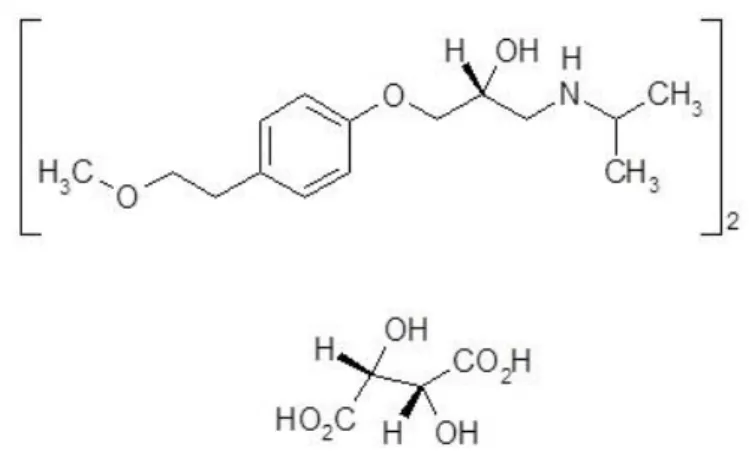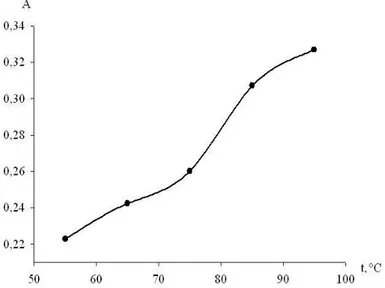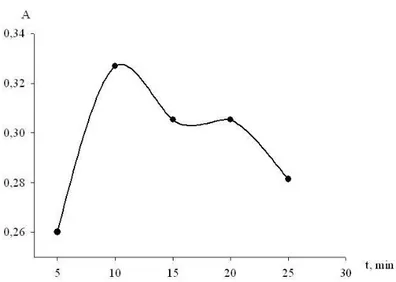ORIGINAL ARTICLE / ÖZGÜN MAKALE
SPECTROPHOTOMETRIC DETERMINATION OF METOPROLOL
TARTRATE IN PURE AND DOSAGE FORMS
SAF VE DOZAJ FORMLARINDA METOPROLOL TARTARATIN
SPEKTROFOTOMETRİK TAYİNİ
Anastasiia DONCHENKO*, Svitlana VASYUK
Zaporizhzhia State Medical University, Pharmaceutical Faculty, Analytical Chemistry Department, Zaporizhzhia, Ukraine
ABSTRACT
Objective: A new spectrophotometric method has been developed for the determination of metoprolol tartrate in pure and dosage forms.
Material and Method: This method is based on the reaction between metoprolol tartrate and 2,3-dichloro-1,4-naphthoquinone in dimethylformamide (DMF) medium to form the colored reaction product with maximum absorption at 493 nm. Optimum conditions to carry out the reaction such as concentration of reagent, temperature and heating time were carefully studied and optimized. Beer’s law was performed at the concentration range of 18.00-28.00 mg/100 ml. The proposed method is valid according to the validation requirements of the State Pharmacopoeia of Ukraine.
Result and Discussion: The results of the study show that the procedure is accurate, simple and relevant for application at the quality control laboratories for dosage forms.
Keywords: 2,3-dichloro-1,4-naphthoquinone; metoprolol tartrate; spectrophotometry; validation studies
ÖZ
Amaç: Metoprolol tartaratın belirlenmesi için saf ve farmasötik ilaçlarında yeni spektrofotometrik bir yöntem geliştirildi.
Gereç ve Yöntem: Bu yöntem 493 nm’de maksimum emilim ile boyalı reaksiyon ürünün oluşturulması için dimetilformamid (DMF) ortamında metoprolol tartarat ile 2,3-dikloro-1,4-naftokinon arasında olan reaksiyona dayanmaktadır. Reaksiyonun yapılması için reaktif konsantrasyonu, sıcaklık ve ısıtma süresi gibi
* Corresponding Author / Sorumlu Yazar: Anastasiia DONCHENKO
e-mail: donchenko130791@gmail.com
göre geçerlidir.
Sonuç ve Tartışma: Çalışma sonuçları, işlemin ilaç formları için kalite kontrol laboratuvarlarında uygulama açısından doğru, basit ve güncel olduğunu göstermektedir.
Anahtar kelimeler: 2,3-dikloro-1,4-naftokinon; metaprolol tartarat; spektrofotometri; validasyon çalışmaları
INTRODUCTION
One of the most common noninfectious diseases in many countries of the world is cardiovascular diseases. During the last years mortality from circulatory system diseases have significantly declined, but they remain the main cause of sudden death in Ukraine [1]. Specialists carry out the development of new drugs for improving the quality of treatment. Also significant attention is paid to the improvement of existing treatment regimens with drugs that have proven effective not only in large randomized trials but also in the daily practice of doctors. β-adrenergic blockers can be attributed to them. These drugs are prescribed for treatment of arterial hypertension, ischemic heart disease, chronic heart failure and various arrhythmias (supraventricular tachycardia, atrial fibrillation, ventricular extrasystole and others). In this case, an advantage is given to such blockers of β-adrenergic receptors, which have a long half-life, the favorable balance of lipophilic and hydrophilic properties and high cardioses selectivity. One of such drugs is metoprolol tartrate [2].
Metoprolol tartrate is a selective blocker of β1-adrenergic receptors which used to treat high blood pressure (hypertension) and congestive heart failure [3]. Chemically it is bis[(2RS)-1-[4-(2-methoxyethyl)phenoxy]-3-[(1-methylethyl)-amino]propan-2-ol] (2R,3R)-2,3-dihydroxybutanedioate with the molecular formula C34H56N2O12 (Figure 1). European and British Pharmacopoeia recommend titrimetric method with potentiometric fixation end-point for the assay of metoprolol tartrate [4, 5]. According to the literature data, spectrophotometry [6, 7], HPLC [8], spectrofluorimetry [9] are the most widely used techniques for the determination of metoprolol tartrate. These methods are highly sensitive, selective, cost-effective and available to quality control laboratories for dosage forms. However, there is a need to find new analytical reagents. In this issue, derivatives of quinone are promising, namely 2,3-dichloro-1,4-naphthoquinone.
Figure 1. The chemical structure of metoprolol tartrate
Therefore, the purpose of this work was to develop and validate spectrophotometric method based on reaction with 2,3-dichloro-1,4-napthoquinone for the determination of metoprolol tartrate in pure and dosage forms.
MATERIAL AND METHOD
All chemicals and reagents used were of analytical or pharmaceutical grade.
The research objects: tablets “Metoprolol tartrate” 50 mg (“Farmak” PJSC, Ukraine, series No.
20617), tablets “Metoprolol” 50 mg (“Kievmedpreparat” PJSC, Ukraine, series No. 176802).
Materials and reagents: pure metoprolol tartrate substance (Sun Pharmaceutical, series
AH-9-46930), 2,3-dichloro-1,4-napthoquinone (Sigma–Aldrich Corporation, USA, D67200), dimethylformamide (DMF) (BASF, China, series 20150611).
Apparatus: Analytic Jena UV-visible spectrophotometer model Specord 200 with 1 cm matched
quartz cells, Kern electronic scales ABT-120-5DM, water bath (Memmert WNB 7-45).
Reagents and solutions
naphthoquinone 4%: It was prepared by dissolving 4 g of
2,3-dichloro-1,4-naphthoquinone in 100 ml of DMF.
Working standard solution 0.23%: It was prepared by dissolving 0.2300 g of pure metoprolol
tartrate in 100 ml of DMF.
Procedure for calibration graph
The aliquots of the working standard solution containing 18.00-28.00 mg of metoprolol tartrate were transferred into a series of test tubes. 1 ml of 4% 2,3-dichloro-1,4-naphthoquinone was added. The resulting reaction mixture was heated on the water bath at 95°C for 10 min. After cooling, the contents of the tubes were quantitatively transferred into a series of 10 ml calibrated flasks and diluted to volume
Procedure for dosage forms
Twenty tablets were weighed and powdered. An accurately weighed quantity of the powdered tablets (for tablets “Metoprolol” – 0.3230 g, for tablets “Metoprolol tartrate” – 0.3450 g) was transferred into a 25 ml calibrated flask and diluted to volume with DMF. Obtained solutions were mixed and filtered. First portions of filtrate were discarded, since the first portions of the filtrate were cloudy. The aliquots of the obtained solution were analyzed according to the procedure for calibration graph.
RESULT AND DISCUSSION
In the present work, we investigated the development of spectrophotometric determination of metoprolol tartrate in pure and dosage forms. It was experimentally established that pure metoprolol tartrate reacts with 2,3-dichloro-1,4-naphthoquinone in DMF medium to formation the reaction product with maximum absorption at 493 nm. The absorption spectrum of product is recorded in Figure 2.
Figure 2. Absorption spectrum of metoprolol tartrate (0.23 %) against DMF (- - -); naphthoquinone (4%) against DMF (····); reaction product of metoprolol tartrate with 2,3-dichloro-1,4-naphthoquinone against reagent blank (──)
Optimum conditions to carry out the reaction between metoprolol tartrate and 2,3-dichloro-1,4-naphthoquinone has been established during the process of development this procedure. The influence of various parameters such as nature of the solvent, concentration of reagent, temperature, time of heating was investigated.
The choice of the solvent for this reaction was based on the metoprolol tartrate and 2,3-dichloro-1,4-naphthoquinone solubility data. In the result, DMF became the optimal solvent for this reaction.
Necessary quantity of reagent was determined experimentally by reaction product maximum yield, i.e. by maximum value of absorbance. To this end, the reaction of the substance of metoprolol tartrate with the reagent at concentration of 1-5% was investigated. The absorption maximum was attained at 2,3-dichloro-1,4-naphthoquinone concentration of 4% (Figure 3).
Figure 3. Effect of reagent concentration on the reaction of metoprolol tartrate with 2,3-dichloro-1,4-naphthoquinone. Metoprolol tartrate (0.1%): 1 ml, reagent: 1 ml, temperature: 95°С, reaction time:10 min.
The effect of temperature and heating time on formation of the reaction product was studied too (Figure 4, 5). The highest absorption was obtained after heating at 95°С for 10 min.
Figure 4. Effect of temperature on the reaction of metoprolol tartrate with 2,3-dichloro-1,4-naphthoquinone. Metoprolol tartrate (0.1%): 1 ml, reagent (4%): 1 ml, reaction time:10 min.
Figure 5. Effect of heating time on the reaction of metoprolol tartrate with 2,3-dichloro-1,4-naphthoquinone. Metoprolol tartrate (0.1%): 1 ml, reagent (4%): 1 ml, temperature: 95°С.
Validation of the proposed method
All of the validation characteristics for the proposed method were determined according to requirements of the State Pharmacopoeia of Ukraine. The following parameters were considered: specificity, linearity, accuracy, precision and robustness.
Specificity
During the study of the specificity of the method, the contribution of auxiliary substances included in the dosage forms in the total absorption of the solution was determined. For this purpose, the absorption of placebo solutions and working standard solution of metoprolol tartrate was measured. It has been found that this contribution is insignificant for the investigated dosage forms. The resulting spectrum is shown in Figure 6.
Figure 6. Absorption spectrum of placebo of tablets “Metoprolol tartrate” (- - -); placebo of tablets “Metoprolol” (····); reaction product of metoprolol tartrate (0.23%) with 2,3-dichloro-1,4-naphthoquinone (──)
Linearity
To determine the linearity, 9 measurements of the absorption of the working standard solution of metoprolol tartrate were performed in the range of concentrations in which the obedience of a Beer’s law was observed, namely 18.00-28.00 mg/100 ml. The calibration graph of the absorption from metoprolol tartrate concentration was plotted according to the obtained data. It is given in Figure 7.
Figure 7. Calibration curve of metoprolol tartrate at 493 nm
The linearity of proposed method was evaluated by the linear regression analysis, which was calculated by the least square method. Received values are given in the Table 1.
Table 1. Optical specifications and basic parameters of linear dependency
Molar absorption coefficient, ε
1278.4
Sendel’s coefficient, W
S0.5356
Identification limit, С
min(g/ml)
26.78
Equation of linear regression
Y = bX + а
Slope, b±(S
b)
0.0178±(0.0003)
Intercept term, а±(S
a)
0.0115±(0.0080)
Residual standard deviation, S
x,o0.1741
Сorrelation coefficient, r
0.9987
Precision
The precision of the proposed method for each dosage form was determined at the level of repeatability. For this purpose, 9 parallel measurements were performed. Of the three weights, three solutions were prepared, each with three parallel measurements under optimum conditions. In parallel,
Table 2. Precision determination results for metoprolol tartrate dosage forms
Dosage form Content
Metrological characteristics
Х S RSD Δx,r %
As Δ
Tablets “Metoprolol tartrate” 0.050 g 0.0499 3.8·10-4 0.768 1.42 3.20
Tablets “Metoprolol” 0.050 g 0.0501 3.4·10-4 0.693 1.28 3.20
Х - mean, g; S – standard deviation; RSD – relative standard deviation;Δx,r – relative confidence interval;
%
As
Δ – critical value for repeatability of results
Accuracy
Accuracy was established by standard addition method. In the experiment, to three equal samples of the appropriate dosage form were added a known amount of working standard solution of metoprolol tartrate (n = 9). Then the absorption of the solutions obtained was measured. The accuracy of the method was evaluated as the ratio added/found. The results of the determinations are correct, if there is no meaningful systematic mistake, i.e. the true value of the determined amount is getting in a setting confidence interval. The obtained data are given in Table 3.
Table 3. Accuracy determination results for metoprolol tartrate dosage forms
Dosage form Taken
mg/100 ml Additive mg/100ml ∆Z RSD ∆ Z |Z−100| Tablets “Metoprolol tartrate” 18.64 4.60 100.40 0.497 2.77 0.40 18.64 6.90 18.64 9.20 Tablets “Metoprolol” 18.47 4.60 100.03 0.345 1.92 0.03 18.47 6.90 18.47 9.20
∆Z – mean, %; RSD – relative standard deviation;∆Z – sided confidence interval;
|
Z−100|
– systematic error RobustnessDuring the test of robustness, the influence of time on the stability of the tested solutions was investigated. For this purpose, the absorption of the analyzed solution of the appropriate dosage form (A1 – for tablets “Metoprolol tartrate”, A2 – for tablets “Metoprolol”) and working standard solution of metoprolol tartrate (A0) was measured every 5 minutes for 30 minutes (Table 4).
t, min 0 5 10 15 20 25 30 Mean RSD,% t% maxδ,%
A
0 0.4290 0.4295 0.4298 0.4300 0.4307 0.4314 0.4310 0.4302 0.199 0.380.51 A1 0.4277 0.4281 0.4286 0.4290 0.4299 0.4300 0.4298 0.4290 0.214 0.41
A2 0.4301 0.4306 0.4310 0.4312 0.4321 0.4328 0.4331 0.4316 0.261 0.51
RSD,% – relative standard deviation;
t% – confidence interval; maxδ,% – critical value of the systematic error
According to the table, t%≤ maxδ,%, i.e., the test solutions are stable for at least 30 minutes.CONCLUSION
Simple and reproducible spectrophotometric method has been developed for quantitative determination of metoprolol tartrate in pure and
dosage forms
. The proposed method is valid according to the validation requirements of the State Pharmacopoeia of Ukraine. The results of the study show that the method is precise, simple and relevant for application at the quality control laboratories for dosage forms.REFERENCES
1. Kovalenko, V., & Dorohoy, A. (2016). Sertsevo-sudynni khvoroby: medychno-sotsialʹne
znachennya ta stratehiya rozvytku kardiolohiyi v Ukrayini [Cardiovascular disease: medical and
social significance and the strategy of cardiology development in Ukraine]. Ukrayins'kyy
kardiolohichnyy zhurnal, 4(3), 5-14.
2. Buchhorn, R., & Borst, M. (2017). The History and Future of Beta Blockers in Heart Failure Treatment in Children and Adults. Medical Research Archives, 5(9), 1-11.
3. Mashkovskiy, M. (2012). Lekarstvennye sredstva [Medicine remedies]. Moscow: Novaya Volna. 4. European pharmacopoeia (2011). (7th ed.). Strasbourg: Council of Europe.
5. British Pharmacopoeia (2009). London: The Stationery Office.
6. Nabil A. F., A., & Eman. M., S. (2015). Spectrophotometric determination of metoprolol in pharmaceutical formulation by charge transfer complexation. International Journal Of Chemical
Studies, 3(2), 24-29.
7. Cesme, M., Tarinc, D., & Golcu, A. (2011). Spectrophotometric Determination of Metoprolol Tartrate in Pharmaceutical Dosage Forms on Complex Formation with Cu(II). Pharmaceuticals,
4(12), 964-975. http://dx.doi.org/10.3390/ph4070964
8. Hussain, S., R.Munjewar, R., & Farooqui, M. (2012). Development and Validation of a Simultaneous HPLC Method for Quantification of Amlodipine Besylate and Metoprolol Tartrate in
Spectrofluorimetric Method Based on the Oxidation with Cerium (IV) for the Determination of Four Different Drugs in Their Pharmaceutical Formulations. Pharmaceutical Sciences, 23(1), 50-58. http://dx.doi.org/10.15171/ps.2017.08
10. State Pharmacopoeia of Ukraine (2015). (2th ed). Kharkiv: Ukrainian Scientific Pharmacopoeial Center for Quality of Medicines.





